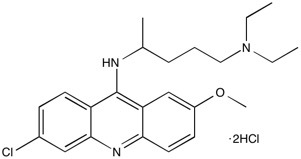Quinacrine HCl | Antiprotozoan / Anticancer
NMR (Conforms)

Available Options
| Size: | Price | Quantity | |
|---|---|---|---|
| 20 mg | $30.00 | ||
| 100 mg | $50.00 |
Quinacrine HCl (69-05-6) is an antiprotozoan drug used for malaria and giardiasis and has recently been investigated in treating lupus, as an anticancer agent, inflammation, and as a female sterilization agent.1 It has been found to have synergistic effects with vorinostat in the treatment of T-cell acute lymphoblastic leukemia via mitophagy blockage and an increase in ROS.2 Quinacrine displayed antitumor effects in an intestinal cancer mouse model and HCT116 p53-/- xenografts via reduction in Chk1/2 expression and cell death induction in the G2-M phase.3 It promotes autophagic cell death in ovarian cancer cells via downregulation of p62/SQSTM1.4 Quinacrine is also an inhibitor of phospholipase A2.5
References/Citations:
1) Ehsanian et al. (2011), Beyond DNA binding – a review of the potential mechanisms mediating quinacrine’s therapeutic activities in parasitic infections, inflammation, and cancers; Cell Commun. Signal. 9 13
2) Jing et al. (2018), Vorinostat and quinacrine have synergistic effects in T-cell acute lymphoblastic leukemia through reactive oxygen species increase and mitophagy inhibition; Cell Death Disease 9 589
3) Park et al. (2018), Therapeutic Effect of Quinacrine, an Antiprotozoan Drug, by Selective Suppression of p-CHK1/2 in p53-Negative Malignant Cancers; Mol. Cancer Res. 16 935
4) Khurana et al. (2015), Quinacrine promotes autophagic cell death and chemosensitivity in ovarian cancer and attenuates tumor growth; Oncotarget 6 36354
5) Chan et al. (1982), Biphasic modulation of platelet phospholipase A2 activity and platelet aggregation by mepacrine (quinacrine); Biochim. Biophys. Acta 713 170
NMR (Conforms)
Safety Data Sheet:
Product Data Sheet:
Materials provided by Focus Biomolecules are for laboratory research use only and are not intended for human or veterinary applications. Please note that we do not sell to individuals and that all orders placed by non-research organizations will incur a $20 restocking/refund fee
Quinacrine HCl (69-05-6) is an antiprotozoan drug used for malaria and giardiasis and has recently been investigated in treating lupus, as an anticancer agent, inflammation, and as a female sterilization agent.1 It has been found to have synergistic effects with vorinostat in the treatment of T-cell acute lymphoblastic leukemia via mitophagy blockage and an increase in ROS.2 Quinacrine displayed antitumor effects in an intestinal cancer mouse model and HCT116 p53-/- xenografts via reduction in Chk1/2 expression and cell death induction in the G2-M phase.3 It promotes autophagic cell death in ovarian cancer cells via downregulation of p62/SQSTM1.4 Quinacrine is also an inhibitor of phospholipase A2.5
References/Citations:
1) Ehsanian et al. (2011), Beyond DNA binding – a review of the potential mechanisms mediating quinacrine’s therapeutic activities in parasitic infections, inflammation, and cancers; Cell Commun. Signal. 9 13
2) Jing et al. (2018), Vorinostat and quinacrine have synergistic effects in T-cell acute lymphoblastic leukemia through reactive oxygen species increase and mitophagy inhibition; Cell Death Disease 9 589
3) Park et al. (2018), Therapeutic Effect of Quinacrine, an Antiprotozoan Drug, by Selective Suppression of p-CHK1/2 in p53-Negative Malignant Cancers; Mol. Cancer Res. 16 935
4) Khurana et al. (2015), Quinacrine promotes autophagic cell death and chemosensitivity in ovarian cancer and attenuates tumor growth; Oncotarget 6 36354
5) Chan et al. (1982), Biphasic modulation of platelet phospholipase A2 activity and platelet aggregation by mepacrine (quinacrine); Biochim. Biophys. Acta 713 170
Calculate the molar concentration, mass or volume in a solution.
Concentration × Volume × Molecular Weight = Mass
Focus Biomolecules • Plymouth Meeting, PA USA • 1-855-FOCUS21
Focus Biomolecules
Plymouth Meeting, PA USA
1-855-FOCUS21
Website Created by Advanta Advertising LLC.

